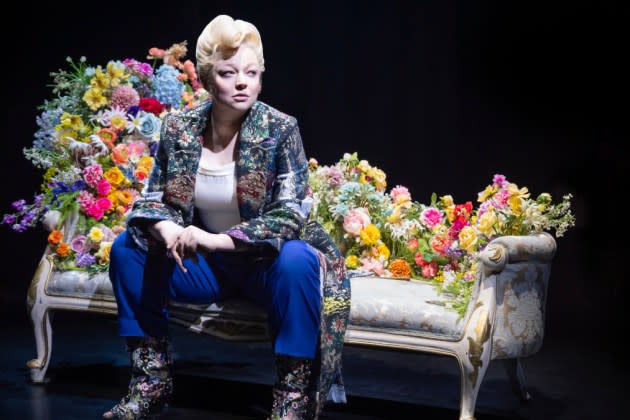‘The Picture of Dorian Gray’ Review: Sarah Snook Dazzles in a Flashy Stage-Meets-Screen Retelling
- Oops!Something went wrong.Please try again later.
- Oops!Something went wrong.Please try again later.

Oscar Wilde himself sat in the Royal Box in the West End’s beautifully gilded Theatre Royal Haymarket in the 1890s for the premieres of his comedies “A Woman of No Importance” and “An Ideal Husband.” Given the glitteringly dangerous ideas that drive his only novel, “The Picture of Dorian Gray,” it seems more than likely he would have applauded the sheer audacity of writer-director Kip Williams’ new, dizzyingly high-tech adaptation, in which all 26 characters in the mostly-male Faustian pact are played with delicious range and wholly arresting zeal by “Succession” Emmy winner Sarah Snook.
The only character traits that the versatile Snook chooses to carry forward from her “Succession” character Shiv Roy is the gleaming sense of entitled ambition. That’s the hallmark of the beautiful title character, whom initially we do not meet.
More from Variety
Williams’ staging of his own adaptation opens with a fierce close-up of Snook’s exuberant face on a large, portrait-style screen — the first of many — hanging down at the center of the proscenium arch. Simultaneously, towards the back of the bare, black, open stage, we watch her being filmed. She’s setting the scene, narrating a discussion between Basil, the painter of Dorian’s portrait, and Dorian’s friend and mentor Sir Henry Wotton. But what threatens to be a sub-Ivo-van-Hove evening of filmed images flattening live performance almost immediately develops layers of fascination and tension thanks to David Bergman’s state-of-the-art video, projection and film work.
The most famous fact of this (im)morality tale is that while he lives a life of increasing indulgence and license, Dorian’s Gray perfect image, captured on canvas and hidden in the attic, rots. Cunningly, that’s the only picture the production never shows. Instead we are treated to an increasingly animated gallery of Snook’s ferocious characterizations in a gothic story that grows ever darker as Dorian proves that (as Wilde later wrote) “nothing succeeds like excess.”
The opening narration swiftly turns to acted conversation with Snook’s head turning wittily in a flash to face three separate cameras, adding both Basil and Henry to her narrator roles. And from then on, the presentation plays more and more sophisticated games with the very idea of presentation, a central theme in a story about a man abandoning his soul in order to retain his perfectly beautiful body and face. The story remains linear; the telling of it — with camera crew and stage-management prowling and dashing about — is anything but.
The technical sophistication grows and grows, often with high-level wit creating a wicked sense of camp mirroring the themes of the novel. Interrogating his own beauty begins with just a glorious gleam in Snook’s eye beneath a bubbly blond wig, as his ever more “perfect” face is projected on multiple screens and made ever more false.
Camerawork splashed across them is mixed with filmed sequences allowing Snook to play and simultaneously interrogate multiple characters in dialogue. By the time Dorian fatally re-meets the now terrified painter, the conversation between the two of them, played out live and on film by the same person, feels utterly natural, a tribute to the performance and to the winning craft that has gone before.
Designer Marg Horwell’s simple, stripped-back stage pieces allow for multiple locations. Many of them are knowingly theatrical — there are laughs from a book notable for a lack of them — and they’re delineated by an intensely floral aesthetic which, although stopping short of anything as literal as a green carnation, floods Snook’s often hilariously arch and braying characters with color.
Together with everything from Clemence Williams’ fierce arrangement of Vivaldi’s “Winter” from “The Four Seasons” to Bock and Harnick’s hymn to self-adoration “Gorgeous” from “The Apple Tree” and Giorgio Moroder’s “I Feel Love,” the ever-surprising sound world is integral to the production’s success in building a world that snares the audience.
Unlike the original whose prose lingers at (too) much length in self-admiration, this stage-meets-screen version largely keeps its foot on the accelerator. Only in the final stretch does momentum fail. Just at the point where we need the tale to climax, as terrified, febrile Dorian’s horror peaks, tension slackens.
The element missing from this bravura evening is the engagement of feeling: there is more emoting than heartfelt emotion. But, in Williams and Snook’s defense, that’s absent from the original too and anyone seeking sincerity from “The Picture of Dorian Gray” is looking in the wrong place. Not for nothing did Wilde observe that “The first duty in life is to be as artificial as possible.”
Best of Variety
Sign up for Variety’s Newsletter. For the latest news, follow us on Facebook, Twitter, and Instagram.
